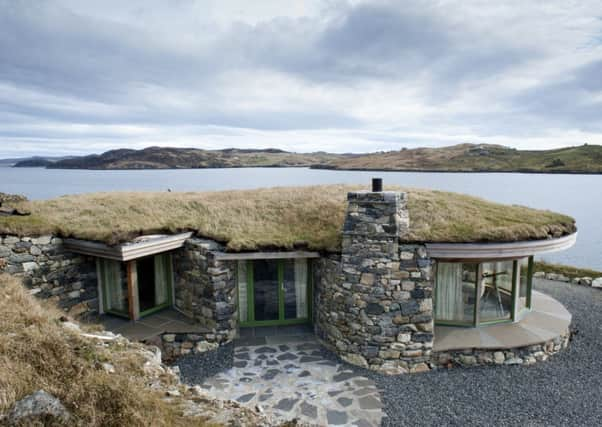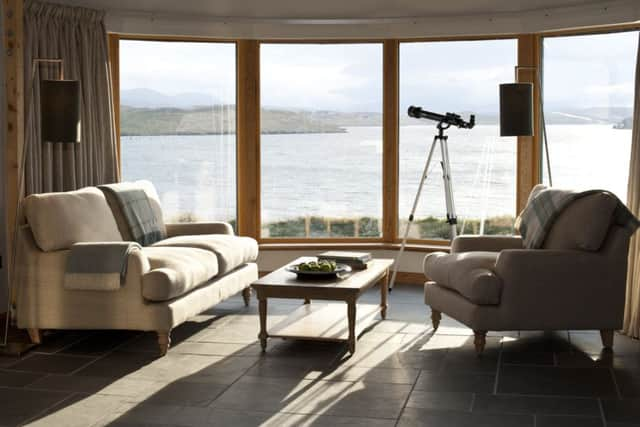Travel: Hobbit heaven in Lewis cottage


On the second night it is as smooth and solid as poured concrete, and that it generates light at all seems impossible. And on the third night it is massive, full and ancient, each crater so perfect it appears to have been carved out with an ice-cream scoop. For the first time in my life I see moonlight, the stuff of poetry, sending a vast searchlight across the water before dissolving into sparkles that dance like fireflies and make me doubt my own eyes. It’s as though I never really saw the moon until I came to the Outer Hebrides.
This is what happens when you have the luxury of a telescope in your living room and a panoramic view of nature at its most dramatic unfolding night after night. I say night, but the days are so long on Lewis in summer that the dark doesn’t arrive until midnight, when it descends as swiftly and completely as if a switch had been flicked. Light can be dark here, and dark light. Such distinctions become meaningless. Walkers often set off into the hills in the small hours. Lamps must be switched on at lunchtime while a storm briefly blows over.
Advertisement
Hide AdOur location is a tiny turf-roofed stone cottage on the eastern coast of Lewis. It’s so cleverly and harmoniously tucked into a headland that you can easily drive past and miss it, which of course we did. From early evening this impossibly luxurious hideaway (I give you one word: sauna) takes on the character of a private theatre as we pour a whisky and take our seats once more for the greatest show on Earth.


This is the Outer Hebrides after all, a long chain of more than 60 islands strung out into the Atlantic. And Lewis is the most northerly of them. A large, low-lying isle of peat and Presbyterianism, howling winds, stone circles, fragile machair, insanely beautiful sands, and rugged moors studded with the ruins of old blackhouses and wisps of bog cotton. Our cottage is in a miniscule village called Keose about 15 minutes south of Stornoway. After a three-hour sail from Ullapool across the Minch, we arrived at night, though of course it was still light. A Tesco delivery van tailed us all the way to our destination, waiting patiently every time we paused at a lonely passing place to gawp at the landscape. Nothing moves fast here, even the shock intervention of a supermarket.
The two Eagle Bay cottages are the kind of stripped-back slate and glass affairs you would expect to see on Grand Designs. Indeed, their architect is Stuart Bagshaw, designer of a neighbouring Grand Designs Home of the Year on Harris. They are sophisticated in all the right ways and seriously romantic, from the DVD collection (though with what was going on outside we never turned on the television once) to the chilled champagne and hamper of local produce on arrival. Everything is muted, slated and heated, with 180-degree views, lots of exposed curved beams, and a terrace carved into the rock outside. Then, of course, the sauna, which after a day spent being blown around the beaches and cliff tops of Lewis and Harris, is the most welcome of luxuries. The overall effect is of a 21st-century hobbit house: rotund, hunkered into its little shire and very cosy.
We get lucky with the weather, though every islander I speak to tells me, with the air of sharing a carefully guarded secret, that summers are usually good on Lewis. Some days are so hot, in fact, that we go out without jumpers or jackets (in Scotland!) and eat every meal on the terrace. Each time we stumble upon yet another spectacular beach, from the giant expanse of Uig where the Lewis Chessmen were found to Tolsta with its lyrically named Bridge to Nowhere, the first thing we do is kick off our sandals and head for the sea. Always bracingly cold, true, but no amount of sun can turn the north Atlantic into the Med. After a day’s beachcombing we head home via Stornoway to buy fresh fish from the harbour shop that is such good value I have change from a fiver. Once home, the French doors are thrown open and the sauna revved up. Another perfect day.
It’s the beaches that really blow the mind with their stacks of Lewisian gneiss, powdered golden sands and impossibly clear turquoise waters. Every picture you’ve seen of one of Scotland’s beaches masquerading as the Caribbean will probably have been taken here. And this year Lewis and Harris were named Best Island in Europe by the TripAdvisor website. Harris probably has the edge over Lewis with Luskentyre, frequently voted one of the top ten beaches in the world, and my personal favourite, Scarista. Here you get a spectacular view of Taransay and the Harris hills, a great carpet of machair sprinkled with wildflowers, and, when we were there, a lone beach buggy bumping across golden sands, flying a kite.
The Lewis and Harris thing has always confused me. I’ve never understood why these two islands, formed as they are by a single land mass, are separate and distinct. However, it takes on a strange logic when you spend time here. Lewis has the panoramic views, the people and the stone circles. Harris has the mountains, the lunar landscapes, the tweed and the beaches. The Golden Road, also known as The Bays because of its multitude of miniature fjords, is one of the most incredible I’ve travelled, though I probably would say that as the passenger. A sinewy single-track road connecting tiny settlements with Gaelic and Viking names that I couldn’t pronounce if you paid me, it often appears to hover as much over water as land. That a road exists here at all, let alone has been here in some form since 1897, is extraordinary. On the day we drive it the sun is high and scorching, making the lochs and grey rocks sparkle, the Tarmac shimmer, and the Uists glow like lighthouses in the distance. Eagles circle overhead, and now and then we pass a steading or, more often, a blackhouse ruin, the stones slowly being swallowed back into this ancient landscape. Afterwards we head to the lovely Skoon Art Cafe in Geocrab, where we sit outside and munch hot smoked salmon, oatcakes, and home-baked cake. There’s nothing like great food in what feels like the middle of nowhere.
Advertisement
Hide AdThe drive home becomes familiar but never less than thrilling. We no longer pause in passing places but there is no taking this landscape for granted. Every time we see and hear new things. An ancient broch on a hill, a camper seeking out a spot on the machair, the call of a corncrake which the poet Kathleen Jamie perfectly described as a “crex-crex”. And always, when we get home to our turfed hideaway, the moon waiting for us in the dark light.
• Hebtember is a fortnight of events this month, celebrating the rich heritage of the Hebrides, visitouterhebrides.co.uk
Advertisement
Hide AdFor more information on Eagle Bay Cottages and availability, visit www.eaglebaycottages.co.uk, email [email protected] or call 01851 830 489. Prices start at around £500 for two nights. The owners are offering a 10 per cent discount for any week-long stay in 2014 or 2015 booked before 30 September. The following code can be used when placing secure bookings online: 496MC